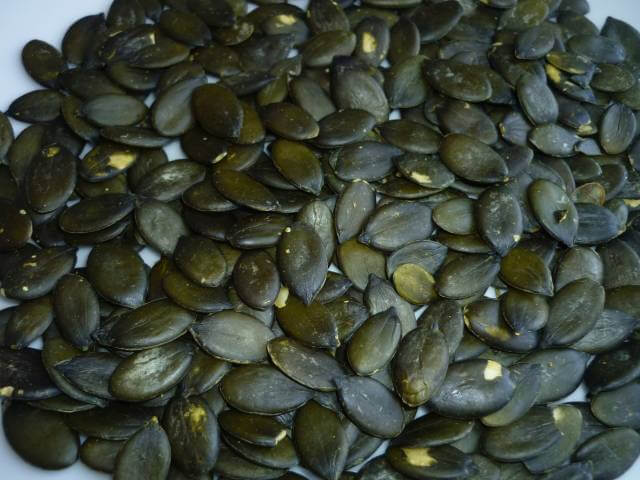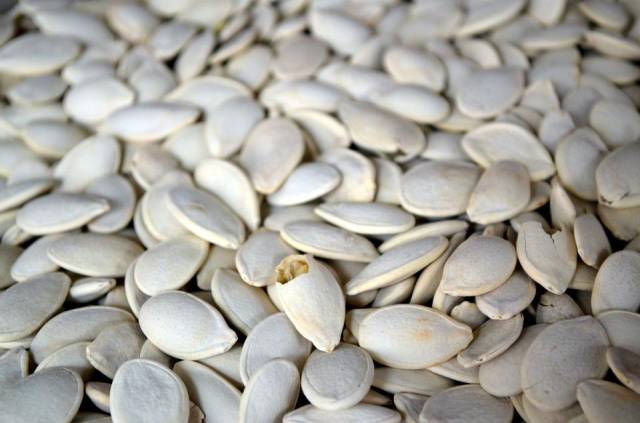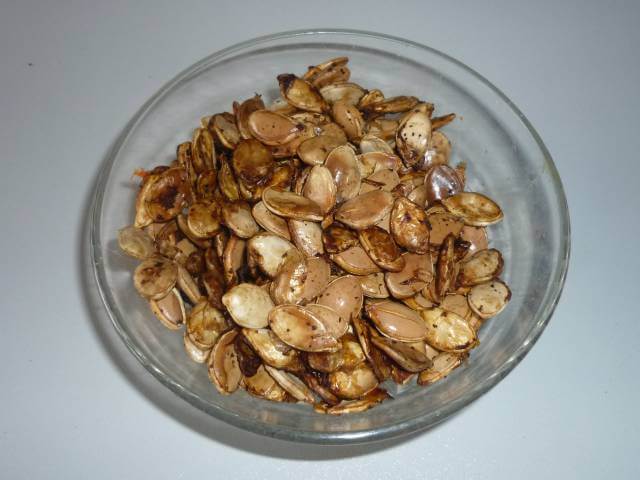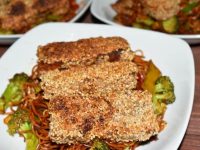Pumpkin seeds are a treasure chest of nutrients, health benefits, and versatile uses. According to science, this is why and how you should add these crunchy seeds to your snacks.
These small seeds are capable of mighty wonders, be it the task of maintaining your health or satisfying your taste buds.
What Makes Pumpkin Seeds A Secret Superfood
Pumpkin seeds are a fantastic source of magnesium, which regulates more than 300 enzyme functions in your body. Still, typical western cuisines lack this highly significant mineral. Snacking 50g of pumpkin seeds can fulfill the 70% daily magnesium intake requirement.
In case you’re unaware, magnesium is an effective cure for stress. It, as well as tryptophan, promotes a good sleep!
Pumpkin seeds also bring a massive amount of protein, vitamin K, zinc, iron, potassium, and copper. Moreover, they have adequate unsaturated fats, B-group vitamins, and various plant compounds.
However, the micronutrient package is high in energy. A 50g serving contains nearly 300 calories. Don’t worry – dietary fiber will make you feel full after munches of a few bunches.
Canned pumpkin seeds are equally nutritious. If you want to avoid extra calories, make sure to bypass products with added sugar and sodium.
Anti-oxidative, Anti-inflammatory properties
Ancient cultures have treasured pumpkin seeds as a folk remedy for kidney and bladder infections. Scientific studies have also found them rich in antioxidants. They devour harmful free radicals, protecting against innumerable diseases.
In general, crunchy seeds and their by-products are linked to a reduced risk of prostate, urinary, and sexual dysfunctions. A 2009 research declared pumpkin seed oil as a safe and sound treatment for benign prostatic hyperplasia (BPH).
Carotenoids are plant pigments responsible for a myriad of wonders. These phytonutrients are found in squash and carrots, giving them a pulpy orange look.
Beta-carotene is a rare pigment that your body converts into vitamin A. Its deficiency is the leading cause of blindness and several eye disorders. Thus, vitamin A is nature’s prime offering to enhance your vision.
In addition, pumpkin seeds have a substantial quantity of vitamins C and E. They equip your immune system to better fight illness and inflammation.
The warrior against cancer and heart diseases
Anti-cancer and cardio-protective features of pumpkin seeds adorn them with a unique position in culinary spheres. They might ward off certain cancers if you tailor your diet regimen. The carotene composition acts as a natural sunblock, reducing the risk of skin cancer.
Multiple laboratory tests spotted desired traits for stomach, colon, and lungs health as well.
Pumpkin seeds are important for women’s wellness. Plant estrogen can prevent breast cancer. And its ample supply of zinc is crucial during the pregnancy cycle.
A clinical trial involving 35 postmenopausal women showed a promising effect of pumpkin seed oil on blood pressure and cholesterol. Both are the unwelcoming risk factors of lethal heart attacks.
Magnesium supports cholesterol-lowering functions. However, the ability of antioxidants to spike nitric oxide in your body is an authentic deal-maker. This gas manages smooth blood circulation.
Some animal studies equated the consumption of pumpkins with lower blood sugar levels. Nonetheless, more studies are required to fully tap its benefits for diabetic patients.
Your companion on the weight-loss journey
The nutrient density of pumpkin seeds is second to none. And guess what – the yummy, wholesome treat is also suitable for shedding some extra pounds!
Pumpkin seeds carry a great deal of fiber. It facilitates punctual and proper digestion. It also curbs your appetite rather quickly, complementing a calorie-restricted diet. Exploring other carb-packed options, such as grains and potatoes, will take away a large chunk of daily calorie allowance.
Overall, the nutrition profile of pumpkin seeds is ideal for any healthy diet plan. It provides much-needed protein, vitamins, and heart-healthy oils. If you avoid consuming these minerals for a long time, a fractured metabolic process will trigger obesity.
Therefore, the American Heart Association calls it a “healthy punch” and suggests eating a quarter cup every day.
It’s pertinent to include a handful of pumpkin seeds for efficient calorie management. Look out for raw, shelled, and unsalted seeds to optimize fiber intake.
Infinite ways to spice up your diet plan
Pumpkin seeds can play dynamic roles in your kitchen – from trail mixes to muffins, pestos to purees, and salsas to salads. Hence, adding them to snacks is limited to your imagination only.
An easy way to instantly absorb the benefits of pumpkin seeds is to grind them in flour. You can further blend hulled seeds to produce homemade pumpkin seed butter. Whether it’s bread or butter spread, nutty-flavored seeds can slip undetected.
Similarly, people drizzle pumpkin seed oil on their dishes for a textured finish!
If you’re unwilling to process further, raw seeds give you plenty of room to innovate. Brighten up your bowl of cereals and granola with a crispy twist. Just put the delicious pumpkin seeds or their powder in the original recipe.
Garnish your favorite soup, salad, and pasta. Other complementary uses are possible while baking cookies, stirring smoothies, or toasting Mayan dips.

What are pumpkins?
The pumpkin is one of the oldest cultivated plants in the world. The many varieties that are popularly eaten today are cultivars that originated in Central and South America, where they were cultivated by the natives of Peru and Mexico approximately 8,000 years ago.
Pumpkins are a genus of plants, the Squash (Cucurbita), a group of fruiting vegetables. Botanists divide pumpkin plants into 2 groups, the edible squash and the inedible gourds.
Decorative gourds are not good to eat as they contain cucurbitacins. The bitter substances are toxic and even small amounts can cause gastrointestinal problems, gourds should therefore not be eaten. The squashes that are eaten today are free of these bitters as they have been selectively bred out.
If you are a hobby gardener, only use purchased seeds for annual sowing, as there is a possibility of cross-pollination between gourds and squash type of pumpkins. Because if you replant pumpkin seeds from your own harvest, there is a risk that the bitter substances will appear again if both types of pumpkin are growing in the same area.
What are the best pumpkins?
Pumpkins come in many varieties, but some of the tastiest include Cherokee Bush, Pie, Hokkaido, Spaghetti Squash,
Butternut or nutmeg squash. You can boil them, roast them, bake them, in short, do anything you can think of with them.
Depending on the type, pumpkins taste very mild and somewhat nutty, they are just as delicious as a standalone dish as they are as a side dish. Classic dishes are pumpkin pie and pumpkin soup. Here is an easy vegan recipe with spaghetti squash.
Types of pumpkin seeds
Pumpkin seeds are also known as pepitas, an indigenous Mexican term. Scoop them out of any pumpkin; they will be edible but wildly different in color, texture, and flavor.
You’ll find two types of pumpkin seeds in grocery stores. Green seeds without shell and the raw white seeds in a fibrous husky shell.
Why are pumpkin seeds green?

The green pumpkin seeds available everywhere in stores are the seeds of the Styrian oil pumpkin (Cucurbita pepo).
The seeds of this species do not need to be hulled as they do not have a hard, fibrous shell, just a paper-thin skin.
Pumpkin seed oil is also obtained from this type of pumpkin seed. The seeds from the Styrian cultivars are more expensive, savory, and nutritious than their hulled cousins.
White pumpkin seeds have a husk

The pumpkin seeds of most other pumpkin varieties have a fibrous husk that contains the small oily seed. They are all edible, but the seeds of some pumpkin types are quite small.
The healthy pumpkin seeds are always left over when you cook a pumpkin dish.
You can lay them out on a kitchen towel and let them dry, and use them in a few days or prepare them straight away and roast them.
Can you eat pumpkin seed shells?

Whether you eat pumpkin seeds with or without the shell depends on your taste and your teeth. While eating pumpkin seeds in the shell is not harmful to health, it is often not much fun to chew on the straw-like, fibrous shell. Fortunately, the shells often burst open during roasting and it is easy to get to the tasty kernel.
If not, then the trick to get to the roasted pumpkin seeds in their shell is to hold them upright between your teeth with the pointed side toward your mouth. Then bite down on the thickest part and crack open the shell and loosen the kernel.
You can even eat the raw pumpkin seeds, although the roasted pumpkin seeds are more aromatic, raw pumpkin seeds contain even more valuable nutrients.
How to roast pumpkin seeds?
Roasting pumpkin seeds with a little oil and spices will add a wonderful aroma. You can then eat them as a snack or they are a great topping for soups and salads. You can roast the pumpkin seeds in a pan or in the oven. It’s hard to say which of the two methods is better, it’s best to try it to know what you deem best.
Roasting white pumpkin seeds is good because then the shell softens a bit and is easier to eat. The green seeds of the Styrian oil pumpkin can be roasted briefly in a pan, that’s the easiest way, but as I just said, you can also enjoy them raw. Here’s a simple five-step guide to doing that anytime!
Pick The Right Pumpkin
A flavorful pumpkin ensures surreal seeds within. Pumpkins with large seeds are best suited. Some squashes, such as spaghetti squash, have really tiny seeds, and you can roast them, but the kernels are so small that it’s really tough work to get them out of the shell
If you plant pumpkins in your garden yourself, then you can choose those varieties that produce large seeds. Then, harvest it as soon as the first frost of autumn hits your backyard.
However, looking after vines for months is not a prerequisite for enjoying a cup of roasted pumpkin seeds. Get your hands on a giant pumpkin from the nearest local farm in case gardening is not your thing.

Scoop out the seeds
Anyways, you have got a bright orange pumpkin upfront on a table. It’s time to cut its hard rind open. Use a sharp knife to rip it in half, starting from the stem.
Each side generally hosts abundant seeds. Most of them will come out with a quick scrap. You should use a serving spoon to collect seeds from all corners.
Keep gathering goopy seeds wrapped in the fibrous pulp. Once done with this step, tear off these strands with your hands. Or make them wet to set seeds free. A few pulpy pieces don’t make much of a difference while roasting.
Blot the seeds dry
Experts often recommend soaking and sprouting pumpkin seeds. It simplifies the baking process and enhances the bioavailability of nutrients. Yet, allocating time for this endeavor is up to you.
Put the seeds into a fine mesh colander. Put it under the sink, and run cold water. You can knead the whole pulp and pumpkin mash in the colander a little with your hand so that the seeds come loose from the pulp. If they don’t all come loose, it doesn’t matter. Now you can remove debris and any leftover bits.
Next, sandwich all pumpkin seeds between paper towels. Press the upper sheets for five minutes. After saying farewell to the moisture, transfer dry seeds into another pot.
Add spicy seasonings

Once pumpkin seeds are washed and towel-dried, they are all set to visit your oven. But why not season them prior?
Toss olive oil or avocado oil in a pot full of seeds. Two tablespoons of oil will suit one cup of seeds. Later, coat them with your favorite spicy blend of seasoning. There are unlimited options to produce a savory and sweet mix with the existing pantry.
You can go with a mixture of salt, red and black pepper, garlic powder, cinnamon, brown sugar, grated cheese, vinegar, or whatever you can think of.
How to roast pumpkin seeds in the oven

Preheat your oven to 300 ⁰F. Place seasoned pumpkin seeds in a single layer on a baking sheet. The seeds will take 10 to 20 minutes to become golden-brown, wood-scented, and crunchy-shelled.
For even roasting, stir them from time to time. If your oven loves hot spots, start with an even lower temperature and gradually increase to 300 ⁰F.
As soon as they are hot enough, many will burst with a pop like you know from popcorn.
Be careful not to roast them too long because they can burn quickly if the oven is too hot or they are in there too long.
How to roast pumpkin seeds in a pan
It’s just as easy to roast the pumpkin seeds in the pan. Pour a little cooking oil into a pan until the bottom is covered.
Put the seasoned pumpkin seeds in the hot pan. Don’t put too many seeds in the pan at once or they may burn.
Close the pan with the lid and place it on the stove over medium heat. The shells pop up after a short time so you can get to the kernel. When most of the shells have cracked, remove the pan from the heat.
- Make Your Own Curry Powder - July 28, 2022
- What Is A Carbon Footprint? - July 25, 2022
- Socca Bread - June 24, 2022



